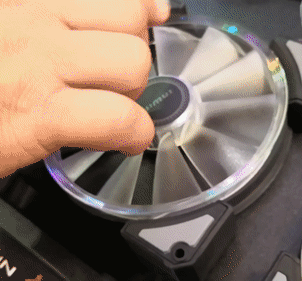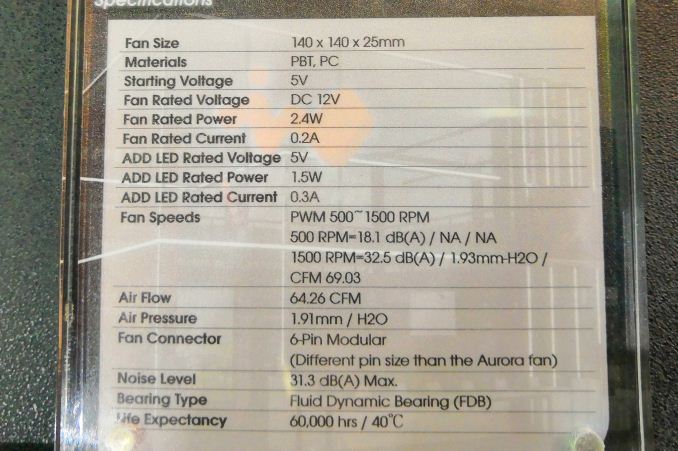The InWin Crown Fan: Why Bother with Closer Fan Blades When the Whole Fan Moves
by Ian Cutress on June 19, 2018 1:00 PM EST
In recent weeks and months, a lot of noise has been made about Noctua’s new fan design that uses precise tooling to create fan blades that are much closer to the edge of the fan than has been used previously. The benefits of such a design are often listed as a better and more powerful airflow. Well perhaps InWin just one-upped Noctua’s design, by fixing the blades to the fan sub-frame and spinning the sub-frame instead
This new fan design uses two main frame platforms: the first, which is fixed to the chassis in the corners, is used as a housing around the outside of the internal subframe as well as carrying the cables into the motor. The second is the subframe, which contains the fan blades fixed from the center to the sub-frame. The end result is that almost the whole fan spins around.
There are pros and cons to this method, including the fan blades getting more air and having more of the sub-frame move can assist with shifting air. The downside is that there is more mass, so the total RPM of the fan (at equal torque) is likely to be lower.
InWin rates these fans at 2.4W, with an average airflow of 64.26 cubic feet per minute, and an average air pressure of 1.91 mmH2O, with a noise level of 31.3 dB(A). The motor is a fluid dynamic bearing and rated for 60,000 hours use. At retail a twin pack of 140mm fans should come in under $60, and 120mm fans are available also.
| Want to keep up to date with all of our Computex 2018 Coverage? | ||||||
 Laptops |
 Hardware |
 Chips |
||||
| Follow AnandTech's breaking news here! | ||||||














35 Comments
View All Comments
megadirk - Tuesday, June 19, 2018 - link
The real question is, if this was the optimal design for static pressure why wouldn't a company like Noctua have released something like this already? Instead of trying to get their blades as close the edge as possible like with their new release.ATC9001 - Tuesday, June 19, 2018 - link
Might not meet Noctua's required profit margins?One thing I don't understand is how it will consume more energy? I'd buy that it does use more energy to get up to speed initially, however, once at steady state speed it would be just like any other fan...when the drag = the power it's in steady state..so if this is more efficient it would move more air than less efficient fan at the same power...and since it does that it's a lower RPM, but who cares, it's moving more air for the same power?
DanNeely - Tuesday, June 19, 2018 - link
frictional losses are proportional to the mass of the spinning part.mongosatan - Tuesday, June 19, 2018 - link
No it doesn't. Does friction increase if you have extra mass in your car at a given velocity? No, the drag is given by the shape of your car and the airspeed.e36Jeff - Tuesday, June 19, 2018 - link
Actually it does. Increase the weight of the car and the wheel bearings will see a proportional increase in load, which will get expressed as additional heat. If what you were saying is true than we could use the same wheel bearing we use on a Miata on a 747 and suffer no issues. Friction accounts for most of the slowing force below around 40-50 mph or so, depending on the exact Cd of the vehicle.wrkingclass_hero - Tuesday, June 19, 2018 - link
The vast majority of resistance you are facing when driving is wind resistance. In my velomobile, even at 20 mph rolling resistance only accounts for 15% of resistance, and even taking a passenger and doubling the load only increases rolling resistance by 30%, which would still be less than 20% of the resistance I'd be facing.Keep in mind that drag increases by a square of speed (or 4 times), so load on a flat surface, going straight, at speed, is really negligible compared to wind resistance at high speeds.
Spunjji - Wednesday, June 20, 2018 - link
But we're talking about a fan here, so none of that is relevant. Mongosatan's comment was inaccurate and further discussion is irrelevant!mongosatan - Wednesday, June 20, 2018 - link
Sure, I was talking about resistance from airflow. If you are talking about friction from the weight of the fan against the axle you are correct about that component, but that is pretty negligible compared to the work against airflow.saratoga4 - Tuesday, June 19, 2018 - link
Frictional losses are not proportional to mass (since the weight of blades is only one force in the system), but they will go up a little if you make the blades heavier. I guess the maximum RPMs are limited, but power consumption isn't too much more.Alexvrb - Tuesday, June 19, 2018 - link
I mean you can argue that power is roughly the same at lower RPMs, if you want. Meanwhile if you run this design at the SAME RPMs, it will eat more power. It's not a significant factor in a desktop. I'd be more interested in bearing longevity and noise over time. A good Noctua is rated at 150K hours and has a 6 year warranty.Still if the price is right these crown fans would be worth checking out for some rigs. They are probably ideal at lower speeds. I'd have to run them through their entire RPM range to see if they make any funny noises at certain speeds, but they look interesting.